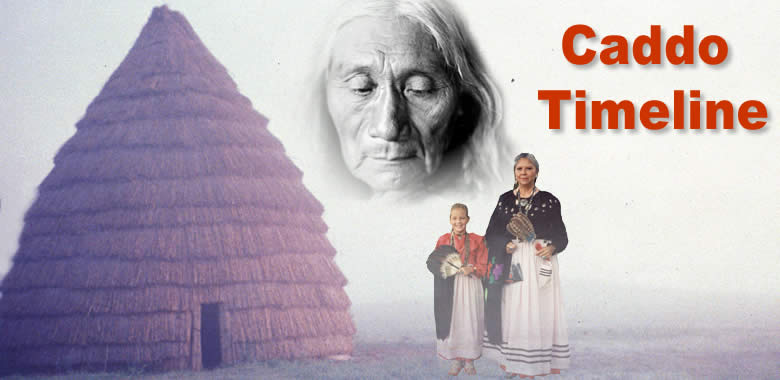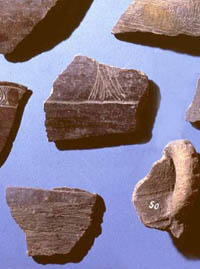
Distinctive potsherds such as these
fragments of Late Caddo pottery from the A.C. Saunders
site allow archeologists to estimate the date of Caddo
settlements. TARL archives. Click to see full image.
|
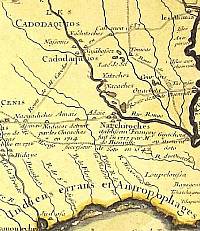
Map showing Native America as perceived
by the French in the early 18th century. This was one
of the first reasonably accurate depictions of the Mississippi
and its tributaries including the Red (Rogue) River.
The locations of Cadohadacho (Cadodaquios), Hasinai
(Les Cenis), and Natchitoches are shown. From Carte
de la Louisiana et du Cours du Mississipi, by Guillaume
Delisle, 1718.
|
|
Over 150 generations of Caddo people have lived
and died since the time more than 3,000 years ago (perhaps
much more) when the ancestors of the Caddo split from the
ancestors of the Northern Caddoan groups (see Caddoan
Languages and Peoples section). Over this long span of
human history, Caddo societies have changed in all kinds of
ways, some of them fundamental. Today we have only an inkling
of most of these changes.
Archeologists find evidence of only certain
kinds of specific events, such as the debris lfet behind from a multi-year settlement, the burning of a house or
the burial of an individual, that leave obvious traces. Most
ordinary events and even those that must have been extraordinary
like victory celebrations, visits by the leaders of distant
groups, and the destruction of a village by a tornado, leave
few traces that an archeologist can recognize. Similarly,
most individuals are invisible in the archeological record.
The only individuals who stand apart in prehistory are those
whose burials we find. Archeologists can recognize patterns
and detect trends through time, but without written or remembered
history to guide us, our view of prehistory is very broad—sort
of like flipping through a history book and seeing only the
chapter titles and a few pictures.
To cope with uncertainty and information gaps,
archeologists construct chronologies (timelines) such as the
one presented below. While such a linear concept of time is
useful to scientists and historians, it would have been foreign
to the ancient Caddo. In most traditional Native American
societies, time was perceived as cyclical and reoccurring.
It was measured and marked by moons, seasons, generations,
and transforming events such as massive floods, celebrated
victories, the founding of a new village, or the death of
a charismatic leader.
However, knowledge of most of the transforming
events in Caddo history has been lost, leaving us with a mix
of faint surviving memories, dance and song tradition, a precious
few detailed early written accounts, and an ever-growing mass
of archeological data from hundreds of archeological sites
linked to the Caddo. This latter may sound impressive, but
most such archeological sites are places where fragments of
Caddo-style pottery have been found on the surface and little
investigation has been carried out. Even with the relatively
few sites that have seen extensive archeological research,
it is often difficult to determine precisely when the sites
were occupied without considerable research effort. Dating is almost always an exercise in approximation
in archeology. Even the radiocarbon dating technique yields
only statistical estimates with decades-long standard error
ranges, rather than precise dates.
Our knowledge of the later history of the Caddo,
after Europeans arrived and began recording information, is
much fuller, but still very incomplete. Europeans only wrote
about what they happened to see or learn that interested or
concerned them. And they always saw the Caddo through the
eyes of strangers in a strange land. As we move toward the
present, our view of history becomes sharper and sharper as
we listen to Caddo voices and compare what they say to what
various officials, travelers, and neighbors wrote. Maps, paintings,
photographs, and voice recordings all add critical knowledge.
With these caveats in mind, we present a culture
history timeline that summarizes some of the major changes
through time. In this chart you will notice that the earlier
periods are longer and are often rounded off into centuries
or even thousands of years. This reflects the lack of precision
of our dating methods. Note also that some of the periods
shown below overlap with one another. This is because time
periods are abstract approximations that cut up time into
neat little blocks out of convenience; in reality things do not
always occur in an orderly linear succession or occur simultaneously
from place to place. Even today in the Digital era, there
are still millions of people across the world that do not
have electricity or running water, technological advances
that most of us take for granted. This example reminds us
that technological and cultural changes typically take decades
or centuries to spread, even today.
|
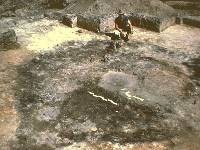
The remains of this burned structure
represent a specific event, the ritual destruction of
a small temple followed by the intentional burial of
the remains with a new layer of earth. Two successive
temples, both burned and buried, were found within and
beneath a small Late Caddo mound at the Harroun site
in Upshur County, Texas. TARL archives.
|
| As
we move toward the present, our view of history becomes
sharper and sharper as we listen to Caddo voices and compare
what they say to what various officials, travelers, and
neighbors wrote. |
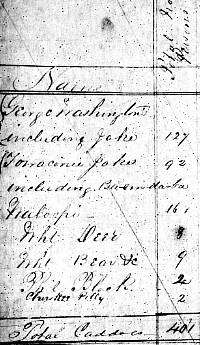
The 1873 census records a total of
401 Caddos, including 116 men, 139 women, 86 boys, and
60 girls as well as 2214 horses, 1032 cows, and 1293
hogs. Courtesy Cecile Carter.
|
|
